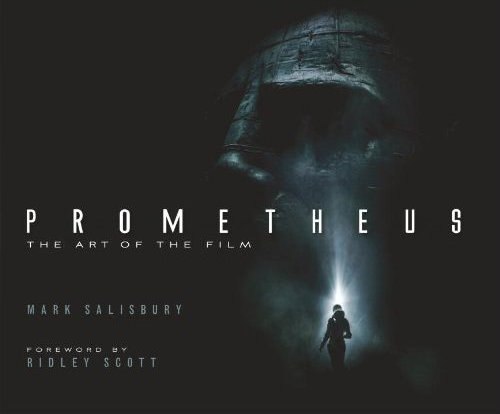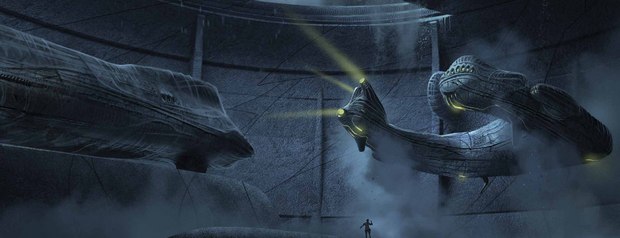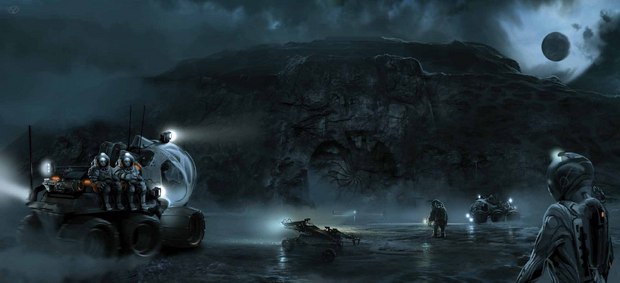Mark Salisbury’s new book provides in splendid detail Ridley Scott’s storyboards, film stills, concept art and other visual materials from his sci-fi epic, Prometheus.
Prometheus: The Art of the Film, by Mark Salisbury. Foreword by Ridley Scott.
London, Titan Books, June 2012, hardback $39.95 (192 pages).
Prometheus: The Art of the Film, the coffee table art book for director Ridley Scott’s Prometheus epic science-fiction feature, is a “visual companion” more than a “making of” volume.
As production designer Arthur Max explains, Prometheus is a not-quite-a-prequel to Scott’s classic Alien (1979), about the discovery by the human crew of the interstellar tug Nostromo of the wreck of an ancient alien spaceship containing a deadly biological lifeform, on the distant planetoid LV-426. The vaguely-backplotted Alien gave rise to many questions, which Scott felt could be answered in a new film with no direct connection to Alien.
Prometheus, released on June 8, 2012, begins with a scene of a huge humanoid on primordial Earth disintegrating himself so that his DNA will eventually evolve into humanity. In 2089 A.D., archaeologists Elizabeth Shaw (Noomi Rapace) and Charlie Holloway (Logan Marshall-Green) discover a 35,000-year-old star map on the Isle of Skye that they feel proves the extraterrestrial origin of mankind. Elderly mega-rich industrialist Sir Peter Weyland offers his corporate resources to construct an exploratory spaceship, the Prometheus, to investigate the location on the star map that they hope will lead to these “Engineers”. In 2093 Prometheus, with a crew of about a dozen in cryogenic suspension watched over by the android David (Michael Fassbender) reach the planet labeled LV-223. They find a lifeless world with several spaceships of the Engineers, including one with the pilot still aboard near a huge artificial Pyramid. Over the course of the film, the Pyramid proves to contain numerous active deadly lifeforms (including a prototype of the later Alien) which they theorize are biological weapons of the Engineers. The one Engineer proves to be still alive and attacks them. To keep the Engineer from returning to Earth and releasing his deadly cargo there, the Prometheus crashes into it. The film ends with Shaw and the decapitated but still active head of David, the only survivors, preparing to leave on one of the other Engineer ships to search for the Engineers’ origins and learn why they are hostile to humans.
(This answers several of the questions raised by Alien, such as how the Weyland Corporation, the owner of the Nostromo, already knew about the “face-huggers” and wants a specimen.)
Prometheus: The Art of the Film contains almost no “making of” information or behind-the-scenes VFX shots. Instead it is rich in photographs of Scott and the production crew, Scott’s own “Ridleygrams” (storyboards), finished film stills, concept art, and art-photo close-ups of the sets of the Prometheus and the interior of the Pyramid. Where the Nostromo in Alien was designed to look like a grungy, well-worn working cargo tug, the Prometheus is a shining new scientific exploratory spaceship on its maiden voyage. Everything about it is as clean and high-tech as production designer Max, senior art Director Marc Holmes, and their crew could make it. The Pyramid, in contrast, is dark and gloomy, with unexplainably inhuman forms that seem more organic than mechanical.
“Scott hired screenwriter Jon Spaihts to begin writing what was then very much an Alien prequel, a story that took place mainly on LV-426 and featured some familiar alien creatures. During the course of the project’s development, however, the script morphed into something else, as the aliens became less important and the idea of the Engineers, the towering race of humanoid-like creatures that have visited the Earth since the Dawn of Time, took centre stage. And with the hiring of screenwriter Damon Lindelof, the script became a standalone story, one which “shares DNA” with Alien, but is not a direct prequel, and not set on LV-426 (“That’s another planet,” confirms Scott).” (pgs. 13, 15)
(A personal nitpick: Prometheus is set in 2093 A.D. Alien was undated, but it was established in the sequels that it was set in 2122 A.D. This rings false to me. I would not think that we could be sending manned exploratory spaceships to the stars within eighty years from now, and commercial interstellar spaceships by only thirty years after that.)
The Pyramid contains many design elements unused on Alien. “Max also pulled archive material from the original Alien from the library at the Academy of Motion Picture Arts and Sciences, which included design work by H. R. Giger, Ron Cobb, Chris Foss and others, original sketches and drawings that hadn’t been used (though many were published in the ‘making of’ volume The Book of Alien). ‘We went through those and Ridley was very excited to see all this stuff because he hadn’t seen it in a long time. A lot of stuff he wanted to do was included in this archive but hadn’t made it into the original film. He said, ‘Well, maybe we can base something on this,’ and there were drawings from all those original designers we took.’” (p. 24)
It will be mildly disappointing to AWN’s readers that there are no “behind the camera” shots of Prometheus’ VFX work. But the fans of the movie will be pleased by all of the concept art and closeup photographs of the sets. Prometheus: The Art of the Film i sa fine “live action” art book to go alongside all of the art books on animated feature films that have been published recently.
--
Fred Patten has been a fan of animation since the first theatrical rerelease of Pinocchio (1945). He co-founded the first American fan club for Japanese anime in 1977, and was awarded the Comic-Con International's Inkpot Award in 1980 for introducing anime to American fandom. He began writing about anime for Animation WorldMagazine sinceits #5, August 1996. A major stroke in 2005 sidelined him for severalyears, but now he is back. He can be reached at fredpatten@earthlink.net.











